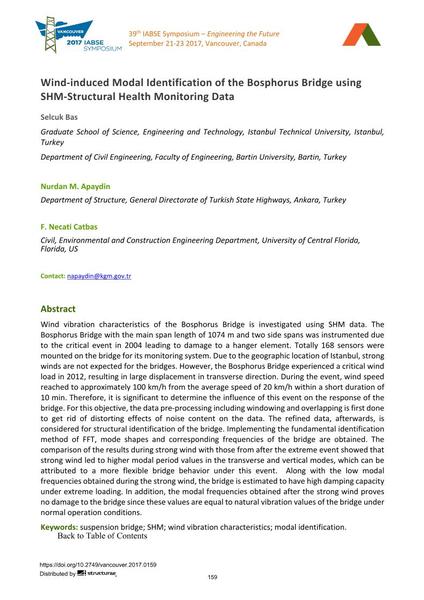Wind-induced Modal Identification of the Bosphorus Bridge using SHM-Structural Health Monitoring Data

|
|
|||||||||||
Bibliographic Details
| Author(s): |
Selcuk Bas
Nurdan M. Apaydin F. Necat Catbas |
||||
|---|---|---|---|---|---|
| Medium: | conference paper | ||||
| Language(s): | English | ||||
| Conference: | IABSE Symposium: Engineering the Future, Vancouver, Canada, 21-23 September 2017 | ||||
| Published in: | IABSE Symposium Vancouver 2017 | ||||
|
|||||
| Page(s): | 159-166 | ||||
| Total no. of pages: | 8 | ||||
| Year: | 2017 | ||||
| DOI: | 10.2749/vancouver.2017.0159 | ||||
| Abstract: |
Wind vibration characteristics of the Bosphorus Bridge is investigated using SHM data. The Bosphorus Bridge with the main span length of 1074 m and two side spans was instrumented due to the critical event in 2004 leading to damage to a hanger element. Totally 168 sensors were mounted on the bridge for its monitoring system. Due to the geographic location of Istanbul, strong winds are not expected for the bridges. However, the Bosphorus Bridge experienced a critical wind load in 2012, resulting in large displacement in transverse direction. During the event, wind speed reached to approximately 100 km/h from the average speed of 20 km/h within a short duration of 10 min. Therefore, it is significant to determine the influence of this event on the response of the bridge. For this objective, the data pre-processing including windowing and overlapping is first done to get rid of distorting effects of noise content on the data. The refined data, afterwards, is considered for structural identification of the bridge. Implementing the fundamental identification method of FFT, mode shapes and corresponding frequencies of the bridge are obtained. The comparison of the results during strong wind with those from after the extreme event showed that strong wind led to higher modal period values in the transverse and vertical modes, which can be attributed to a more flexible bridge behavior under this event. Along with the low modal frequencies obtained during the strong wind, the bridge is estimated to have high damping capacity under extreme loading. In addition, the modal frequencies obtained after the strong wind proves no damage to the bridge since these values are equal to natural vibration values of the bridge under normal operation conditions. |
||||
| Keywords: |
suspension bridge modal identification SHM wind vibration characteristics
|
||||
